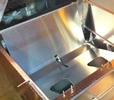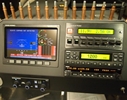


random user submitted photo
Emergency Instrument
8 posts
• Page 1 of 1
Emergency Instrument
Hi All,
I'm beginning to sketch out the instrumentation & wiring for my Turbo Aerovee-powered Sonex, and I wanted to get feedback from folks here. I've read the AEC and the BMA stuff and am trying to balance simplicity against reliability in line with most of their teachings... But most of my career has been spent in the digital world so analog circuitry is pretty new to me. I'd love to hear people's thoughts and suggestions on the situation I explain, below.
I'm aiming to equip my panel with an MGL Discovery Lite, MGL V6, and a Trig TT22. This seems to be a pretty straightforward (yet feature-rich) avionics setup. The only thing that this "single panel solution" lacks is a backup system. I'm a fairly experienced sailplane pilot, so during Day VFR flying I am sure I can eyeball altitude and speed to bring flights to a safe conclusion. But at night I'd be very concerned about judging those things in a darkened cabin if the primary electrical system craps out (either a failure of the Discovery, or a failure of the Batt/Alt system). I was looking at putting in 2.25" analog gauges for ASI & Alt, but its cheaper and less panel-space to just get an MGL Infinity ASX-1 (which provides a 2.25" instrument that gives digital readouts of ASI & Alt). However, the Infinity requires power. So I'm pondering how to best wire the ASX-1 into my aircraft. Here are what appear to be my 3 main options:
Am I being smart, or silly, or missing a good & simple solution that's right in front of my nose? What do you folks think?
Thanks,
--Noel Wade
Sonex #1339
TD, Center-Stick, Acro-Aileron, Flush Pulled Rivets, Turbo Aerovee
Fuselage nearing completion, Wings & Empennage complete.
I'm beginning to sketch out the instrumentation & wiring for my Turbo Aerovee-powered Sonex, and I wanted to get feedback from folks here. I've read the AEC and the BMA stuff and am trying to balance simplicity against reliability in line with most of their teachings... But most of my career has been spent in the digital world so analog circuitry is pretty new to me. I'd love to hear people's thoughts and suggestions on the situation I explain, below.
I'm aiming to equip my panel with an MGL Discovery Lite, MGL V6, and a Trig TT22. This seems to be a pretty straightforward (yet feature-rich) avionics setup. The only thing that this "single panel solution" lacks is a backup system. I'm a fairly experienced sailplane pilot, so during Day VFR flying I am sure I can eyeball altitude and speed to bring flights to a safe conclusion. But at night I'd be very concerned about judging those things in a darkened cabin if the primary electrical system craps out (either a failure of the Discovery, or a failure of the Batt/Alt system). I was looking at putting in 2.25" analog gauges for ASI & Alt, but its cheaper and less panel-space to just get an MGL Infinity ASX-1 (which provides a 2.25" instrument that gives digital readouts of ASI & Alt). However, the Infinity requires power. So I'm pondering how to best wire the ASX-1 into my aircraft. Here are what appear to be my 3 main options:
- Its a miniscule amount of power so I could get a tiny 12v battery and just wire it up separately. But the downside there is I have to remember to keep that backup battery charged or replace it on a regular cycle... It does me no good to have an emergency backup system if its not maintained.
- I could put the backup battery in the loop with the Alternator (to keep it charged all the time). But then I've got to run extra wires and possibly extra OV protection, since I wouldn't want an Alternator problem to fry the backup battery or emergency instrument.
- I could skip the backup battery altogether and just run separate small-gauge wires from the battery through a small fuse and directly to the emergency instrument (isolating the emergency instrument from the main bus and the rest of the aircraft's wiring). The thinking here is that if the Alternator craps out I still have the main battery to run the Discovery or the Emergency instrument, and if the Discovery craps out I can run the emergency instrument off the main battery, and if the main battery craps out I can run the Discovery off of the Alternator. The only "vulnerable" case is a failure of both the Battery and the Discovery at the same time (since I won't have the emergency instrument plumbed into the Alternator output).
Am I being smart, or silly, or missing a good & simple solution that's right in front of my nose? What do you folks think?
Thanks,
--Noel Wade
Sonex #1339
TD, Center-Stick, Acro-Aileron, Flush Pulled Rivets, Turbo Aerovee
Fuselage nearing completion, Wings & Empennage complete.
- NWade
- Posts: 527
- Joined: Mon Aug 08, 2011 3:58 pm
Re: Emergency Instrument
Hi Noel
Backup is a good idea. Since it doesn't sound like youre planning on ifr it shouldn't be too complicated. A GPS navigator, probably nearly any not too old but not necessarily still in production Garmin unit for example, will usually have a page that gives basic simulated instrumentation (all gps based). The unit can be normally powered from the electrical system, and they all have a backup battery built in that will keep it running automatically.
Good Luck, Gordon
Backup is a good idea. Since it doesn't sound like youre planning on ifr it shouldn't be too complicated. A GPS navigator, probably nearly any not too old but not necessarily still in production Garmin unit for example, will usually have a page that gives basic simulated instrumentation (all gps based). The unit can be normally powered from the electrical system, and they all have a backup battery built in that will keep it running automatically.
Good Luck, Gordon
Waiex 158 New York. N88YX registered.
3.0 Liter Corvair built, run, and installed.
Garmin panel, Shorai LiFePo batteries.
3.0 Liter Corvair built, run, and installed.
Garmin panel, Shorai LiFePo batteries.
- GordonTurner
- Posts: 668
- Joined: Tue Feb 21, 2012 1:14 am
- Location: NY, NY
Re: Emergency Instrument
Go low tech. Put a reserve lift indicator (preferably non-electric) or AOA. It could save your life when it counts in an emergency.
John Gillis
SEL Private, Comm Glider, Tow pilot (Pawnee Driver)
Waiex N116YX, Jabiru 3300, Tail dragger,
First flight, 3/16/2013. 403 hours and climbing.
Home: CO15. KOSH x 5
Flying a B-Model Conversion (Super Bee Baby!)
-

fastj22 - Posts: 1594
- Joined: Sun Aug 21, 2011 5:56 pm
- Location: Mile High
Re: Emergency Instrument
I don't recommend a digital solution for the backup insturments. A few months back I had a voltage regulator failure in flight that took out my efis. It failed so only one side of the regulator worked giving me 12v ac instead of DC through my electrical system. If electric backup instruments were installed and turned on they could have been compromised too. Fuses didn't do anything as the instruments never saw an over amperage or over voltage situation. Instead it was like turning them on and off a thousand times a minute that killed the efis.
I was day vfr so it wasn't really an emergency but I did have a backup analog airspeed indicator which helped. Whatever you install I suggest practicing using it in flight. I found it distracting to keep looking at a different place on the panel and going from a digital display to a round indicator. A few hours practice would have made it more natural and comfortable.
Keith
#554
I was day vfr so it wasn't really an emergency but I did have a backup analog airspeed indicator which helped. Whatever you install I suggest practicing using it in flight. I found it distracting to keep looking at a different place on the panel and going from a digital display to a round indicator. A few hours practice would have made it more natural and comfortable.
Keith
#554
- kmacht
- Posts: 772
- Joined: Tue Jun 21, 2011 11:30 am
Re: Emergency Instrument
*
Last edited by daleandee on Sun Apr 30, 2017 8:32 pm, edited 1 time in total.
-

daleandee - Posts: 877
- Joined: Fri Feb 01, 2013 6:14 pm
Re: Emergency Instrument
I have the same LRI. And I think its saved me a time or two.
John Gillis
SEL Private, Comm Glider, Tow pilot (Pawnee Driver)
Waiex N116YX, Jabiru 3300, Tail dragger,
First flight, 3/16/2013. 403 hours and climbing.
Home: CO15. KOSH x 5
Flying a B-Model Conversion (Super Bee Baby!)
-

fastj22 - Posts: 1594
- Joined: Sun Aug 21, 2011 5:56 pm
- Location: Mile High
Re: Emergency Instrument
The ASX-1 will work with a regular 9V battery. You can install a switch that will select in between aircraft power or the 9v battery. You can replace that battery every two years or so. It would be a very compact setup that would provide you the most info for real state of panel. Also basically as relaible as non powered gauges.
Greg Alonso
Zenith CH 701, Rotax
Onex, Aerovee
Greg Alonso
Zenith CH 701, Rotax
Onex, Aerovee
- ga2323
- Posts: 3
- Joined: Sat Mar 29, 2014 12:03 pm
Re: Emergency Instrument
ga2323 wrote:The ASX-1 will work with a regular 9V battery.
Ah, thanks Greg! I somehow skipped over the voltage being sufficient down to 8v (thought it was 10v)...
--Noel
Sonex #1339
- NWade
- Posts: 527
- Joined: Mon Aug 08, 2011 3:58 pm
8 posts
• Page 1 of 1
Who is online
Users browsing this forum: No registered users and 14 guests







